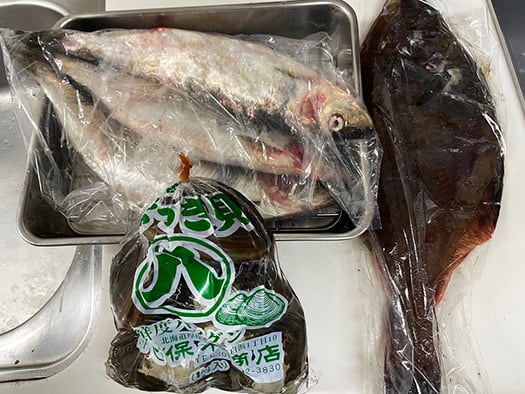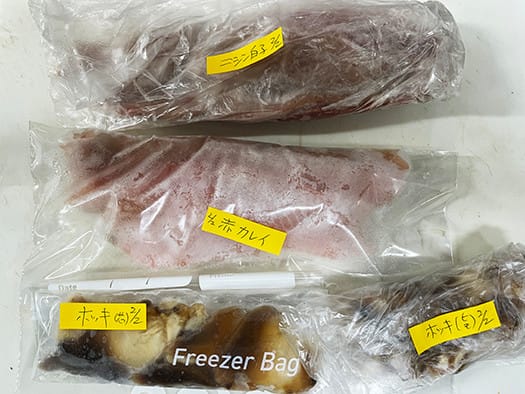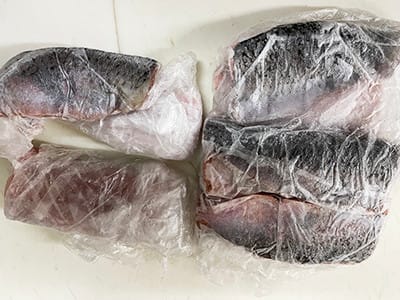
きのうは歴史的大豪雪と大ニュースになっていた北海道・帯広で、スタッフが集合しての住宅工務店企業向けイベント日程。早朝から飛び込んでくるドカ雪の話題を見聞きしながら、ハラハラ心配しながら過ごしておりました。参加工務店さんたちから朝から緊急で「参加ムリ」の連絡が相次いで、急遽リモート開催に切り替えたそうです。関係のみなさんのご理解とご協力に関連会社としても、深く感謝申し上げます。
まことに冬将軍の逆襲、恐るべし。道東は降雪があると言ってもうっすら程度が毎年なので不意打ちの一気降雪。24時間で120cmではまず人命第一。札幌もそこそこの降雪がみられましたが早朝1回の除雪作業で環境確保はできておりました。高速の道東道は無事に除雪完了して本日未明からは全線通行止め解除ということ。本日無事にスタッフが札幌あるいは東京まで、無事帰還を祈っています。
ということですが、後方支援的なスタンスのわたしとしては本日は旬のさかなの話題。緊張するばかりでは誰のためにもなりません。平常心こそが大切、明日の活力。先週土曜日に買い付けていたさかなたちを日曜日に捌いていた話題に場面転換であります。
買い付けてきていたのは余市の魚店など。赤カレイ、ホッキ貝、ニシンの3種。旬と言うことではカレイでしょうが、最近ニシンもよく出回っている。ホッキは通常営業。


赤カレイは1尾700円。ホッキは5コ入りで780円、ニシンは3尾入りで500円程度。全部で2000円に届かないほどの庶民派のおさかなさんたち。値段も合わせて考えると、ありがたさ、いかにも海の幸と思わされますね。謹んで感謝の気持ちを持ちながら、一物全体食的に捌かせていただきました。魚は、きれいに捌いたら骨などの「アラ」まで汁として食することが出来ます。ニシンは小骨が多くて、アラ汁でも大変でしたが、うま味は堪えられませんね。どんなさかなもそれぞれの個性が味覚を提供してくれる。北海道らしい魅力。
捌いた後は、このように冷凍保存することでより安全に味わうことも出来る。アニサキスに対しては冷凍保存がもっとも効果的。
カミさんからは冷凍庫がどんどん膨れ上がっていくので、叱られることもあるのですが、この楽しみには「郷土愛」気分もあるので、じっと耐え忍んでおります(笑)。
English version⬇
Seafood in season ♬♬ Handle it and talk about it
Even in times of heavy snowfall, the source of vitality is seafood from the sea and the mountains. The most important thing is to eat them. The food is a source of vitality for tomorrow.
Yesterday, our staff gathered in Obihiro, Hokkaido, where a historic snowstorm was in the news, for an event for housing construction companies. We spent the day watching and listening to the news of the heavy snowfall from early in the morning, feeling anxious and worried. The participating construction companies urgently contacted us in the morning to say they could not attend the event, so we had to switch to holding the event remotely at short notice. As an affiliate, we are deeply grateful for the understanding and cooperation of everyone involved.
The winter army has really struck back, and we should be afraid of it. The snowfall in the east of Hokkaido is usually only a light dusting, so the level of snowfall was unexpected. 120 cm in 24 hours is a big concern for people's lives. Sapporo also saw a fair amount of snowfall, but even so, the environment was secured with one early morning snow removal operation. The highway, the East Hokkaido Expressway, has been cleared of snow without incident and all lanes have been closed since early this morning. We are praying for the safe return of our staff to Sapporo or Tokyo today.
As a logistical support person, I am talking about seasonal fish today. It is not good for anyone to be nervous all the time. Normalcy is the key, the energy for tomorrow. I'd like to change the subject to the fish we bought last Saturday and processed on Sunday.
The fish we had bought were from fish shops in Yoichi. Three kinds of fish: red flounder, hokki-gai and herring. Flatfish is probably the most popular when it comes to the season, but herring has also been on the market a lot recently. Hokki are usually open for business.
Red flounder is 700 yen per fish. Hoki (hokki) are 780 yen for a pack of five, and herring are around 500 yen for a pack of three. All in all, these common fish are less than 2,000 yen. When you consider the prices together, it makes you think how grateful we are, how much seafood we have. With a sense of gratitude, I was allowed to process the fish in a whole food manner. Fish can be eaten as soup, even the bones and other ‘ara’ if they are processed clean. Herring has many small bones, so it was difficult to make ara-jiru, but the umami is unbearable. Every kind of fish has its own character and offers its own taste sensation. Hokkaido's typical charm.
After processing, the fish can be frozen and preserved in this way for safer tasting. Freezing is the most effective way to protect against anisakis.
My wife sometimes scolds me because my freezer is getting bigger and bigger, but I endure it patiently because there is a sense of ‘hometown love’ in this enjoyment (laughs).




























※コメント投稿者のブログIDはブログ作成者のみに通知されます